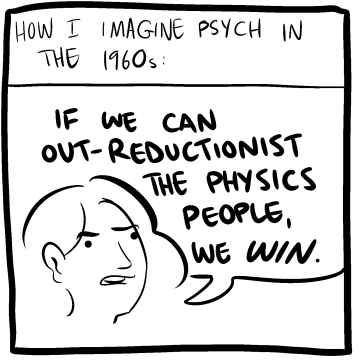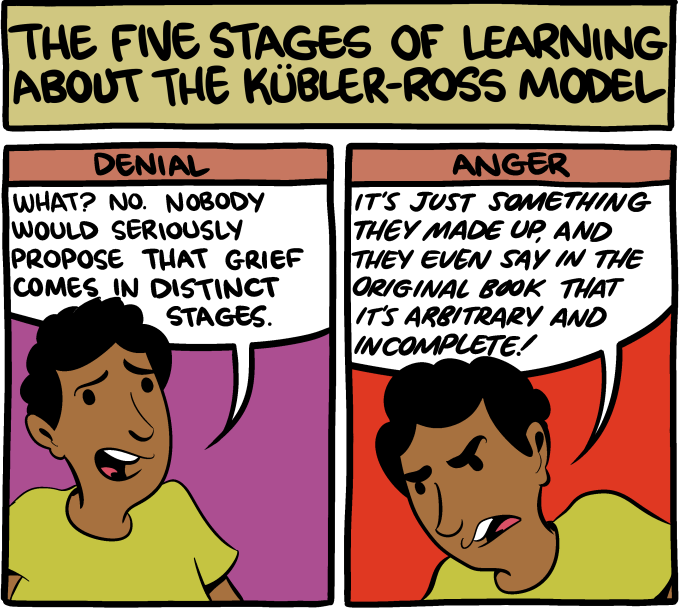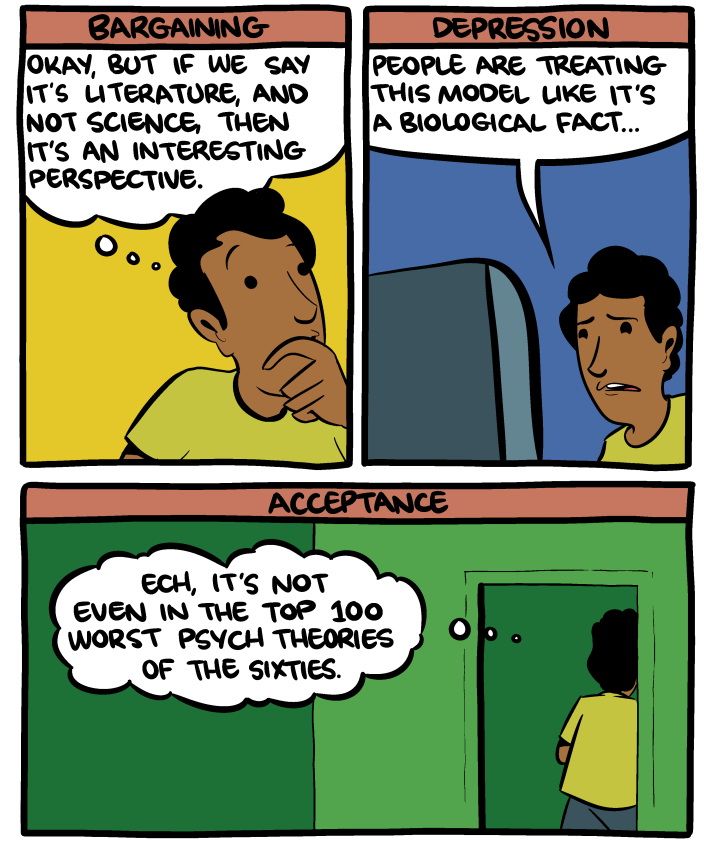July 29, 2015 @ 5:38 am · Filed by Mark Liberman under Linguistics in the comics
« previous post | next post »
Today's SMBC:
The rest of it:
And the aftercomic:

July 29, 2015 @ 5:38 am · Filed by Mark Liberman under Linguistics in the comics
Powered By WordPress


Jon Lennox said,
July 29, 2015 @ 6:37 am
Note that SMBC has a tooltip hover text as well as an aftercomic. In this case, “There are also five stages to accepting that you're reading a meta-joke.”
(I wonder how many people I've just induced to read through the SMBC archive for a third time.)
bks said,
July 29, 2015 @ 8:45 am
The arbitrary enumeration of five stages of grief is more supporting evidence for Chomsky's theory that language is as much about establishing social relations as it is about communication: http://languagelog.ldc.upenn.edu/nll/?p=20182
Perhaps SMBC can cover the sixteen personality types of Briggs Myers in the next installment. –bks
leoboiko said,
July 29, 2015 @ 11:10 am
I like how each panel is in a different color.
Guy said,
July 29, 2015 @ 11:15 am
@leoboiko
I think I agree that denial is definitely a purple mental state. Acceptance doesn't really strike me as green though.
David L said,
July 29, 2015 @ 11:54 am
Acceptance should be beige. That's what you get a bunch of people can't agree on a color and finally say, what the hell, just find something pale and inoffensive.
Ellen K. said,
July 29, 2015 @ 12:58 pm
How do you see the aftercomic on the SMBC website?
Charles Antaki said,
July 29, 2015 @ 2:15 pm
"The five stages of .." has long passed out of Psychology and into the public realm. A swift google search reveals " .. of Watching A Pixar Movie"; "… of Bitcoin"; "… of Reacting to Tatiana Maslany’s Emmy Nomination"; "… of Marie Kondo-ing" …
If these last two are anything to go by, then there is absolutely nothing in human endeavour that can't have five stages; indeed these five stages.
Nathan said,
July 29, 2015 @ 2:28 pm
Ellen K., you click on the big red button under the comic.
Michael Watts said,
July 29, 2015 @ 2:39 pm
Hey, this comic reminds me of the Tongue Map. Easily falsified through personal experience by eating any food at all, and yet people just continue to believe.
Phil Plait complains about the pervasive myth that the moon cannot be seen in the daytime sky, when any idiot could tell that's not true just by looking up once in a while. I feel the same way about the Tongue Map.
Brett said,
July 29, 2015 @ 4:19 pm
@Michael Watts: When I was six or seven, I first encountered the tongue map, and I immediate tried to test it by putting different foods on different areas of my tongue. The lack of any apparent difference in the taste sensitivity confused and upset me.
Duncan said,
July 29, 2015 @ 5:28 pm
@ Michael Watts
But… do you see a big black spot at the location of the blind spot in each eye? No? Why? Because your brain effectively masks it, such that the perception is continuous across it.
Only by deliberate testing (or unfortunate accident!) do most people become aware of their blind spots, and then they might be aware of them but they effectively forget about them in ordinary life, until something brings the fact back to mind.
I expect most people think of the tongue taste map the same way — they believe their sensation of taste in unmapped locations is the the brain making the perception continuous, even if it's not. Between that and the power of suggestibility influencing actual taste-mapping tests, given the actual (in)frequency of such taste-mapping tests in real life, it's easy to see how the myth could continue to be propagated, particularly given that people often received that myth from a source (elementary school science class, etc) they otherwise consider generally reliable and trustworthy, possibly in a context with actual tests and penalties (grades, detention for insubordination to the teacher) for daring to disagree, thus increasing by many fold the power of suggestion.
Of course, if you believe the blind-spot stuff to be myth as well…
Back on the subject, there's a parallel between the five stages of grief, and the four stages of conflict/victory (which I had to look up and count, to be sure it wasn't five), attributed (but disputed) to Gandhi:
First they ignore you, they they laugh at (alternatively, ridicule) you, then they fight (attack) you, then you win (they build monuments to you). See wikiquote (down in the disputed section, which points to a trade unionist as the original author, at least as can be authoritatively attributed):
https://en.wikiquote.org/wiki/Mahatma_Gandhi
I wonder how many people, like me, consider them variants of the same "N stages of" (meta)meme? Actually, now within the LLog context, it occurs to me that the metameme arguably could include the "N words for" meme as well. Thoughts?
Guy said,
July 29, 2015 @ 6:19 pm
@Michael Watts:
I did not know that there were people who thought you could never see the moon during the day, that's especially baffling to me because it doesn't require you to test it, unlike the tongue map which would require you to pay attention to where your putting food on your tongue. Do these people never look up or do they just somehow never notice the moon?
I'm surprised how long the belief that heavy things fall faster than small things persisted even among the most educated in Europe given how easy to falsify it is. Not only are there still many adults who believe this, there are many adults who understand gravity acts the same on all objects but expect it to be unfalsifiable in practice because of air resistance. Unless you're dropping something like a feather or a piece of paper, or are dropping from a height where terminal velocity can be reached, or are making ridiculously precise measurements, air resistance doesn't matter. You can drop a pencil and a heavy textbook from the height of your head and see there is no perceptible difference in falling time.
Adrian Morgan said,
July 29, 2015 @ 7:46 pm
I had the same question as Ellen (where is the aftercomic), so thanks Nathan for answering it.
To bks, and anyone else wanting a satire of the Myers-Briggs, I draw your attention to the fact that if you divide people into:
– [C]at people vs [D]og people;
– [H]aiku people vs [L]imerick people;
– [O]range people vs [A]pple people;
– [W]ars people vs [Trek] people;
– [M]orning people vs [N]ight people
Then a person who likes cats, limericks, oranges, Star Wars and night time is — as you will observe — a CLOWN.
(I won't push the boundaries of Language Log offtopicness-tolerance by categorising myself.)
Guy said,
July 29, 2015 @ 8:23 pm
@Adrian Morgan
Speaking of lampoonings of Myers-Briggs:
http://skepchick.org/2014/12/bad-chart-thursday-who-are-you/
peterv said,
July 30, 2015 @ 2:01 am
Guy @6:19 pm:
Well, educated westerners have known that the earth orbits the sun for at least 500 years, yet we still speak of "sunrise" and "sunset", rather than "earthset" and "earthrise", respectively. Do our everyday words betray a widespread mis-understanding?
Michael Watts said,
July 30, 2015 @ 5:07 am
peterv:
Why would referring to "sunrise" and "sunset" betray any more of a misunderstanding than referring to "the celestial sphere"? The sun really does rise and fall in the sky every day; "earthrise" and "earthset" have no obvious meaning at all. I struggle to understand, though, how your comment responds to anything in Guy@6:19 pm's comment.
If I were speculating on the people who don't believe the moon can be seen during the day, I'd guess they use the following reasoning:
1. The sun is the light in the sky during the day.
2. The moon is the light in the sky at night.
3. Therefore, by definition, the moon cannot be seen during the day, since if it appeared during the day it would be the sun and not the moon.
But, I've never knowingly spoken to one of those people.
Treesong said,
July 30, 2015 @ 8:51 am
I believe it was in Gene Wolfe's Shadow of the Torture tetralogy, set in a far-distant future, that I saw the end of the day mentioned as horizon rising rather than sun setting. But I wouldn't be surprised if there were a biological basis to the perceptual assumption that big things stand still and little ones move.
Bean said,
July 30, 2015 @ 8:58 am
@Guy: about light vs. heavy: I think there is a problem in the way humans perceive weight with their hands (as opposed to a scale). Density factors in and may dominate the perception of "weight". A 45-lb weightlifting plate seems much heavier to me than my 45-lb daughter. That makes no sense, but she's bigger and thus less dense, so I don't perceive her as being as "heavy". Anyway, when a person thinks of something "light" it will be a feather, or a piece of paper, that will flutter to the ground slowly, and probably not a pencil.
D.O. said,
July 30, 2015 @ 9:49 am
@peterv. Sunrise and sunset have nothing (OK, very little) to do with Earth orbiting the Sun. Yet, all this facts about history and astronomy that we all know are somehow bundled together to produce not quite correct statements…
J. W. Brewer said,
July 30, 2015 @ 11:20 am
I am not familiar with Dr. Plait's work, but have a big [citation needed] response to the claim re a significant percentage of people believing the moon is never visible during the day. Among other problems (although this isn't an insuperable obstacle) it would need to be a very recent development. Prior to say 1900 when most of the human species lived in non-urban environments and no one had electric light at night, a reasonably detailed knowledge of lunar phenomena (as they appear from earth, not necessarily as they are in themselves) was one of those things it was probably fairly hard not to acquire.
Guy said,
July 30, 2015 @ 11:53 am
@peterv
No, it doesn't. But like Michael Watts, I don't understand the relationship between your question and my comment. I was talking about people having false beliefs about what will actually happen if certain things are done, not complaining about language usages that would be inaccurate if interpreted "literally" (for some esoteric value of "literally").
Guy said,
July 30, 2015 @ 12:19 pm
@Bean
It's true that we don't really perceive weight directly and instead associate it with various related things like "hard to carry", and that might be consistent with the fact that a large tarp will fall slower than a pencil even though the pencil is actually lighter, but most people would agree that a pencil is lighter than a large book, and accordingly they often incorrectly predict that the pencil will fall perceptibly slower than the book.
Mark Mandel said,
August 1, 2015 @ 8:05 pm
@D.O. July 30, 2015 @ 9:49 am: "Sunrise and sunset have nothing (OK, very little) to do with Earth orbiting the Sun"? They have everything to do with the Sun not orbiting the Earth, which the words "sunrise" and "sunset" imply.
Michael Watts said,
August 2, 2015 @ 1:58 am
Mark Mandel:
In the first place, the words "sunrise" and "sunset" don't make any such implication, any more than the rest of the celestial sphere terminology does. If I pointed out that the moon is roughly 30 minutes across, would you say I was implying that the moon is a temporal rather than spatial entity?
In the second place, sunrise and sunset in addition to having nothing to do with the earth orbiting the sun, also have nothing to do with the sun not orbiting the earth. If the sun did orbit the earth, sunrise and sunset would be just the same.